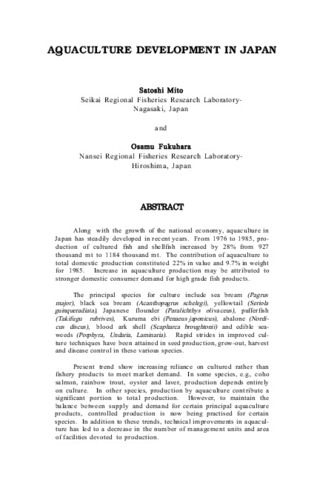Current status of sustainable aquaculture and resource enhancement in Cambodia
- Global styles
- MLA
- Vancouver
- Elsevier - Harvard
- APA
- Help
Share
นามธรรม
Cambodia is rich in both freshwater and marine fisheries resources. Aquaculture in Cambodia has been practiced in the Great Lake (Ton Le Sap) for a long time . The culture method involves stocking of wild juvenile fish in pens or cages and feeding with trash fish. In 1994, a new aquaculture technology was introduced in the country through the Asian Institute of Technology (AIT) outreach programme.
Aquaculture development in Cambodia is part of a national policy under the National
Rectangular Strategy Policies of the Government. To support the national policy, the Fisheries Administration has introduced the updated Strategic Planning Framework for Fisheries (SPFF) for 2015. Meanwhile, the National Strategic Plan for Aquaculture Development in Cambodia (NSPAD) 2016-2030 aims to meet the growing demand for fish for domestic consumption, and future investment requirements in aquaculture development.
The main aquaculture production produced from inland aquaculture accounts for nearly 90% of the total fish production. Aquaculture systems including floating cage/pen culture, earthen pond culture and integrated rice-fish culture, and other fish culture in small scale or aquaculture-based fisheries in Cambodia are practiced in over 20 provinces and cities, with less development on coastal aquaculture
Annual aquaculture production increased by an average of 20 % over the past decade, from 50,000 metric tons in 2009 to 254,048 metric tons in 2018.
Enhancing rice field fisheries productivity continues to be a priority in the Fisheries SPF, especially through Community Fish Refuges (CFRs). Rice field fisheries provides 100,000–150,000 tons per year which contributed 20–30 % of the total inland fish production.
However, knowledge about the current status of the sector is lacking. Anecdotal field observations and the few existing studies depict a sector with unsophisticated technology, low efficiency and low competitiveness against imports from neighboring countries. Limited availability of quality inputs and services is a major constraint to the growth of the aquaculture sector. Fingerling production, in particular, is insufficient and the poor quality of fingerlings produced results in very low levels of production to support the industry leading to the importation of fingerlings from neighboring countries.
การอ้างอิง
Kunthy, R. (2021). Current status of sustainable aquaculture and resource enhancement in Cambodia. In F. A. Aya, L. D. de la Peña, N. D. Salayo, & E. A. Tendencia (Eds.), Proceedings of the International Workshop on the Promotion of Sustainable Aquaculture, Aquatic Animal Health, and Resource Enhancement in Southeast Asia (pp. 1–12). Tigbauan, Iloilo, Philippines: Aquaculture Department, Southeast Asian Fisheries Development Center.
Type
Conference paperISBN
9789719931103 (Print); 9789719931119 (PDF)The following license files are associated with this item:
Except where otherwise noted, this item's license is described as Attribution-NonCommercial-ShareAlike 3.0 IGO
Related items
Showing items related by title, author, creator and subject.
-
The Philippine aquaculture industry
Camacho, Arsenio S.; Macalincag-Lagua, Natividad (Aquaculture Department, Southeast Asian Fisheries Development Center, 1988)The aquaculture sector of the Philippine fishing industry registered the highest growth rate of 12.5% in 1977-1986. The contribution of aquaculture to the total fish production was equivalent to 24% in 1986 compared to ... -
Family farms in Vietnam
Aldon, Eva T. (Aquaculture Department, Southeast Asian Fisheries Development Center, 1997) -
Aquaculture development in Japan
Mito, Satoshi. (Aquaculture Department, Southeast Asian Fisheries Development Center, 1988)Along with the growth of the national economy, aquaculture in Japan has steadily developed in recent years. From 1976 to 1985, production of cultured fish and shellfish increased by 28% from 927 thousand mt to 1184 thousand ...







